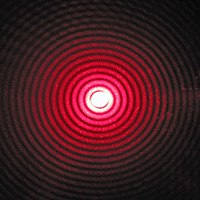
Photo from wikipedia
This paper presents a novel noncontact measurement and inspection method based on knife-edge diffraction theory for corrosive wear propagation monitoring at a sharp edge. The degree of corrosion on the… Click to show full abstract
This paper presents a novel noncontact measurement and inspection method based on knife-edge diffraction theory for corrosive wear propagation monitoring at a sharp edge. The degree of corrosion on the sharp edge was quantitatively traced in process by knife-edge interferometry (KEI). The measurement system consists of a laser diode, an avalanche photodiode, and a linear stage for scanning. KEI utilizes the interferometric fringes projected on the measurement plane when the light is incident on a sharp edge. The corrosion propagation on sharp edges was characterized by analyzing the difference in the two interferometric fringes obtained from the control and measurement groups. By using the cross-correlation algorithm, the corrosion conditions on sharp edges were quantitatively quantified into two factors: lag and similarity for edge loss and edge roughness, respectively. The KEI sensor noise level was estimated at 0.03% in full scale. The computational approach to knife-edge diffraction was validated by experimental validation, and the computational error was evaluated at less than 1%. Two sets of razor blades for measurement and control groups were used. As a result, the lag will be increased at an edge loss ratio of 1.007/µm due to the corrosive wear, while the similarity will be decreased at a ratio of 5.4×10-4/µm with respect to edge roughness change. Experimental results showed a good agreement with computational results.
Journal Title: Applied optics
Year Published: 2021
Link to full text (if available)
Share on Social Media: Sign Up to like & get
recommendations!